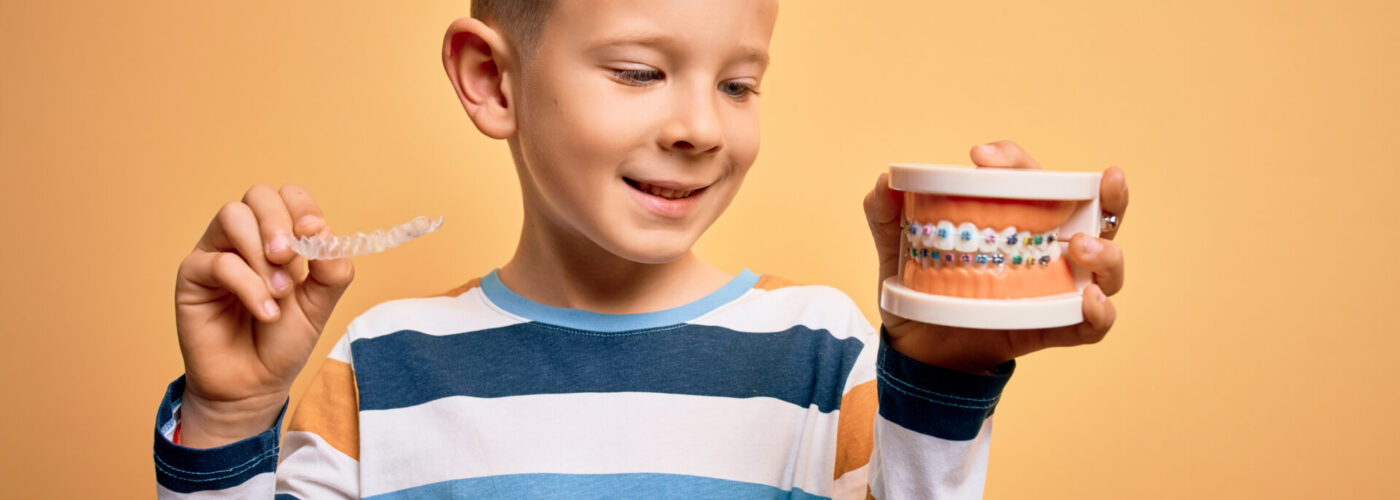The best age for your child to get braces depends on a lot of factors, but there are other orthodontic options that may help them before they’re ready.
Every parent wants their child to have a healthy, pain-free and beautiful smile. For some kids, this may sometimes require orthodontic intervention at a relatively young age, while their teeth and bones are easier to manipulate. Any early orthodontic treatment, however, will come with both pros and cons.
In this the following article, we take a close look at both, so you can have a better understanding of your options as a parent.
When should your child see an orthodontist?
The Australian Society of Orthodontists typically recommends that children visit a registered specialist orthodontist for an initial assessment between the ages of eight and ten to ensure that their teeth, gums and jawbones are all growing correctly.
Even if the child only just has their molars through, an orthodontist will still be able to monitor the growth of the jaw and palate, as well as how the loss of baby teeth is progressing.
Some form of treatment may, however, be recommended if your child has crowded or protruding front teeth, or any difficulty biting or chewing. Speech impediments or the very early loss of baby teeth can also call for some form of treatment.
Typical reasons for early orthodontic treatment
There are several reasons why kids may need early orthodontic treatment. The most typical include:
Protruding top teeth
Top teeth that protrude well in front of the bottom teeth are at greater risk of being chipped or knocked out in an accident. The risk increases further if the lips cannot close comfortably around the top front teeth.
Crossbite
An untreated crossbite at the front of the mouth can potentially affect how teeth wear down over time and also may be associated with some gum problems. Braces or aligners may be able to help.
Impacted teeth
An impacted tooth can be associated with gum problems, decay or the pressure resorption of other teeth. Timely orthodontic intervention with braces can resolve or reduce the severity of such problems.
Narrow palate associated with a crossbite at the back of the mouth
Some children may benefit from the use of a top jaw expander if an orthodontist sees that the palate is significantly narrow. This can be effectively performed in children or adolescents before the palate has fused.
Pros of early orthodontic treatment
As a general rule of thumb (or, indeed, rule of tooth), it can get more difficult to correct some misalignments of the jaw and teeth in older patients.
Straightening your child’s teeth at an early age can sometimes reduce the severity of some tooth, gum or jaw problems and simplify the treatment required in adolescence or adulthood. Very protrusive upper teeth can be an issue if your child plays a lot of sport, as they may be at a greater risk of trauma to the front teeth.
Appropriate orthodontic intervention can prevent damage to the front teeth and gums, prevent teeth wearing down and reduce emotional distress if teasing is occurring at school.
Finally, the sooner your child has a confident smile, the sooner they will start to feel good about them. Bottom line: you will see them smile more.
Cons of early orthodontic treatment
While advice from your orthodontist should always be taken seriously, early treatment won’t suit every child. Braces and aligners need constant care and attention of the sort that some ten-year-olds simply can’t give. Many won’t yet be ready to avoid certain foods, brush adequately well and regularly rinse their mouth out with water. Even the task of not losing a retainer will often be difficult, while some kids just won’t have the emotional equipment to cope if their braces prove itchy or uncomfortable.
Inappropriately provided early treatment can actually result in longer, incomplete and more expensive orthodontic treatment.
There is no point trying to rush into orthodontic treatment if your child is not dentally and/or emotionally ready.
The only way to get a clear picture of whether your child may benefit from early intervention is to consult with a specialist orthodontist.
Orthodontists are the most qualified and experienced clinicians available to manage all tooth and jaw alignment problems. Their specialist knowledge and clinical experience allows them to provide comprehensive advice and also determine the best time to treat a specific orthodontic problem, whether it be as a child, teenager or adult.
You can find an orthodontist near you and book an appointment for your child – no referral necessary.









